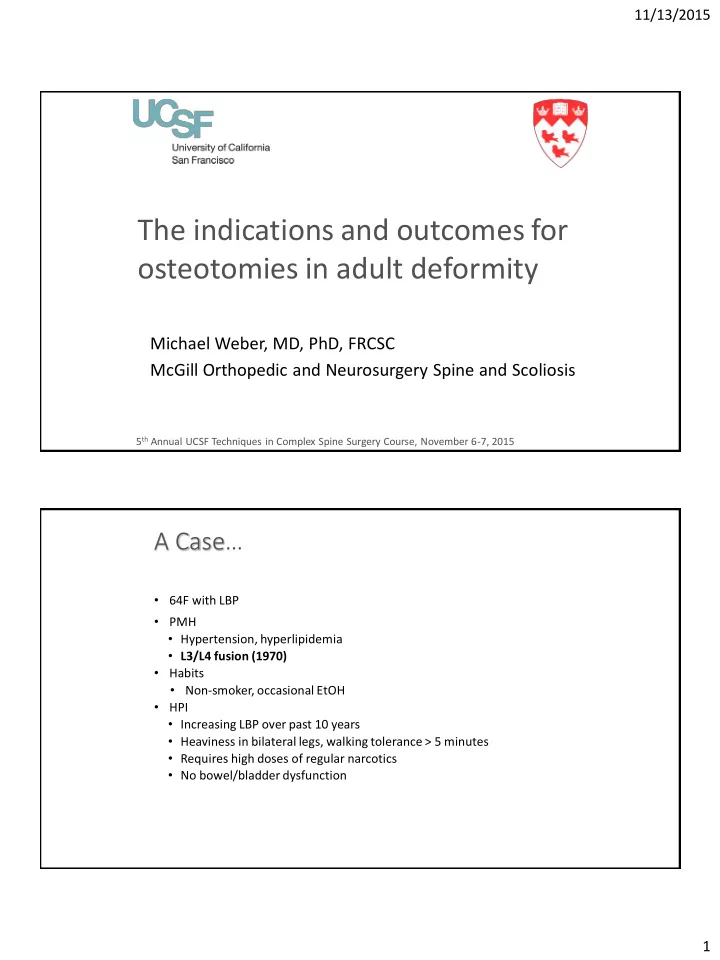

11/13/2015 The indications and outcomes for osteotomies in adult deformity Michael Weber, MD, PhD, FRCSC McGill Orthopedic and Neurosurgery Spine and Scoliosis 5 th Annual UCSF Techniques in Complex Spine Surgery Course, November 6-7, 2015 A Case … • 64F with LBP • PMH • Hypertension, hyperlipidemia • L3/L4 fusion (1970) • Habits • Non-smoker, occasional EtOH • HPI • Increasing LBP over past 10 years • Heaviness in bilateral legs, walking tolerance > 5 minutes • Requires high doses of regular narcotics • No bowel/bladder dysfunction 1
11/13/2015 Physical Exam • Antalgic gait • Motor (R|L) Sensory (R|L) L2 4+ 4+ 2 2 L3 4+ 4+ 2 2 L4 4+ 4+ 2 2 L5 4+ 4+ 1 1 S1 4+ 4+ 1 1 • Patella reflex 1+ bilateral • Straight leg raise (-) bilateral XR SVA = 7.5cm PI = 50º PT = 38º SS = 12º LL = -2º 2
11/13/2015 Sagittal Balance 15º SVA should pass 3cm in front of P-S corner of S1 40º (20º-60º) 0º 60º (30º-80º) Sagittal Balance Sacral Slope Pelvic Tilt Pelvic Incidence 35º +/- 10º 15º +/- 5º 50º +/- 10º 3
11/13/2015 Flat Back Syndrome • Forward inclination of the trunk (i.e. positive sagittal balance) • Compensatory posturing • Retroversion of the pelvis (SS, PT, PI) • Stooping = hip hyperextension + knee flexion • Fatigability and difficulty with gaze • Pain Why is it Important? 4
11/13/2015 Why is it Important? • ↓ Lumbar lordosis and ↑ L3 frontal obliquity correlate with ↓ VAS and general health status • No such correlation with coronal Cobb angle Realignment Objectives • Restore lumbar lordosis • LL = PI +/- 9º • LL = 0.8 x PI • Restore SVA to < 5cm • Restore pelvic tilt to < 20º 5
11/13/2015 Schwab et al. Neurosurgery. 2015 Mar;76 Suppl 1 Corrective Osteotomies • Posterior opening wedge (Smith-Petersen) • Posterior closing wedge (Ponte) • Polysegmental wedges (Wilson &Turkell) • Three column closing wedge (Pedical Subtraction Osteotom) • Vertebral column Resection (VCR) + Large correction - High complication (vessels, bowel) Opening Wedge Osteotomies - Pseudarthrosis 1º per 1mm resection 6
11/13/2015 + Large correction - High complication (vessels, bowel) - Pseudarthrosis 1º per 1mm resection + Spread correction over several levels - Limited correction Closing Wedge Osteotomies 10º per level + Large correction - High complication (vessels, bowel) - Pseudarthrosis 1º per 1mm resection + Spread correction over several levels - Limited correction 10º per level + Can make huge correction + Can correct sagittal and coronal Three Column Osteotomy + less risk of pseudarthrosis up to 60º per level 7
11/13/2015 Pedicle Subtraction Osteotomy (PSO) Three column closing wedge Vertebral Column Resection (VCR) Three column closing wedge 8
11/13/2015 Choice of osteotomy type • ↑ Blood loss with closing wedge • ↑ Paralytic ileus with opening wedge • Comparable patient-reported & radiographic outcomes • Equal dural tear, neurological injury, and reoperation rates PSO Sharp kyphosis Lumbar Smooth kyphosis SPO Smooth kyphosis Thoracic VCR Sharp kyphosis 9
11/13/2015 Choice of osteotomy level • Retrospective, 70 pts underwent lumbar PSO Choice of osteotomy level • PSO correction correlated significantly with thoracic kyphosis, LL, SS and PT 10
11/13/2015 Back to the patient SVA = 7.5cm PI = 50º PT = 38º SS = 12º LL = -2º • PSIF T10-pelvis • L3 PSO • TLIF L5-S1 11
11/13/2015 PSO SVA = 7.5cm SVA = 3.5cm PI = 50º PI = 50º PT = 38º PT = 18º SS = 12º SS = 32º LL = -2º LL = 42º 12
11/13/2015 Six weeks Post-op Complications • Retrospective • 140 patients • PSO for Sagittal imbalance • Multiple etiologies 13
11/13/2015 • Correction with PSO averaged 36.2 ° • Blood loss averaged 1515.6 mL Complications • Scoliosis Research Society (SRS) Morbidity and Mortality Database (2004 to 2007; N=578 patients): • ↑ complication rate with (34.8%) vs. without (17.0%, P < 0.001) an osteotomy • Progresive ↑ in complications from no osteotomy (17.0%), to SPO (28.1%), to PSO (39.1%), to VCR (61.1%). • No difference associated with patient age (P = 0.68), surgeon experience (P = 0.18), and history of prior surgery (P = 0.10). Smith et al., Spine 2011 14
11/13/2015 Complications Failure Predictors • Retrospective 41 patients, 43 TCTOs • IDEAL SPA (SVA< 4 cm, PT < 25°) VS FAIL • ↑ preoperative PT and SVA predicted failed post-operative SPA • ☞ Alternative correction procedures should be considered when planning TCTO for patients with ↑ sagittal malalignment 15
11/13/2015 Take Home Points • Sagittal balance is important! • Functional outcomes are inversely related to SVA • Toolbox of osteotomies to restore spinopelvic aligmen • Posterior opening wedge • Posterior closing wedge • Three column closing wedge • The severity of impairment of LL and spinopelvic parameters correlates with the post op PT and SVA after three column osteotomies The indications and outcomes for osteotomies in adult deformity Michael Weber, MD, PhD, FRCSC McGill Orthopedic and Neurosurgery Spine and Scoliosis 5 th Annual UCSF Techniques in Complex Spine Surgery Course, November 6-7, 2015 16
Recommend
More recommend